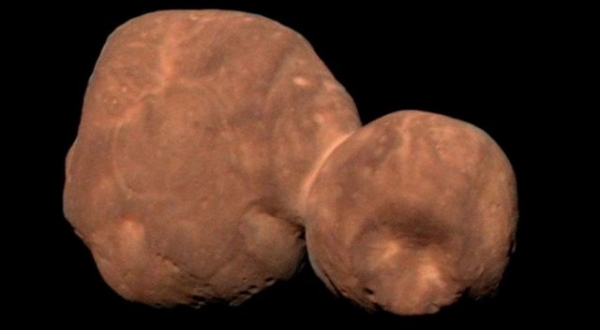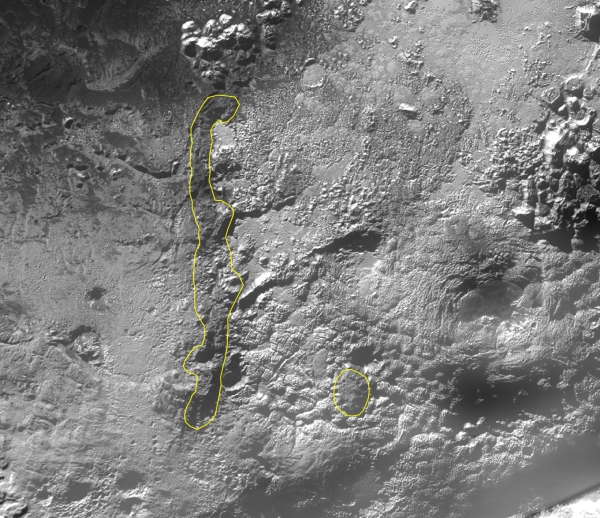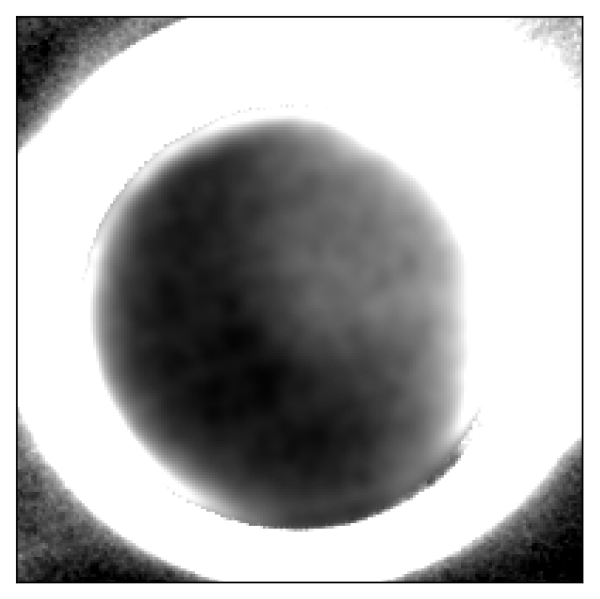The fact that we have three functioning spacecraft outside the orbit of Pluto fills me with holiday good spirits. Of the nearest of the three, I can say that since New Horizons’ January 1, 2019 encounter with the Kuiper Belt Object now known as Arrokoth, I have associated the spacecraft with holidays of one kind or another The July 14, 2015 flyby of Pluto/Charon wasn’t that far off the US national holiday, but more to the point, I was taking a rare beach vacation during the last of the approach phase, most of my time spent indoors with multiple computers open tracking events at system’s edge. It felt celebratory, like an extended July 4, even if the big event was days later.
Also timely as the turn of the year approaches is Alan Stern’s latest PI’s Perspective, a look at what’s ahead for the plucky spacecraft. Here January becomes a significant time, with the New Horizons team working on the proposal for another mission extension, the last of which got us through Arrokoth and humanity’s first close-up look at a KBO. The new proposal aims at continued operations from 2023 through 2025, which could well include another KBO flyby, if an appropriate target can be found. That search, employing new machine learning tools, continues.

Image: Among several discoveries made during its flyby of the Kuiper Belt object Arrokoth in January 2019, New Horizons observed the remarkable and enigmatic bright, symmetric, ring-like “neck” region at the junction between Arrokoth’s two massive lobes. Credit: NASA/Johns Hopkins APL/Southwest Research Institute.
But what happens if no KBO is within reach of the spacecraft? Stern explains why the proposed extension remains highly persuasive:
If a new flyby target is found, we will concentrate on that flyby. But if no target is found, we will convert New Horizons into a highly-productive observatory conducting planetary science, astrophysics and heliospheric observations that no other spacecraft can — simply because New Horizons is the only spacecraft in the Kuiper Belt and the Sun’s outer heliosphere, and far enough away to perform some unique kinds of astrophysics. Those studies would range from unique new astronomical observations of Uranus, Neptune and dwarf planets, to searches for free floating black holes and the local interstellar medium, along with new observations of the faint optical and ultraviolet light of extragalactic space. All of this, of course, depends on NASA’s peer review evaluation of our proposal.
Our only spacecraft in the Kuiper Belt. What a reminder of how precious this asset is, and how foolish it would be to stop using it! Here my natural optimism kicks in (admittedly beleaguered by the continuing Covid news, but determined to push forward anyway). One day – and I wouldn’t begin to predict when this will be – we’ll have numerous Kuiper Belt probes, probably enabled by beamed sail technologies in one form or another as we continue the exploration of the outer system, but for now, everything rides on New Horizons.
The ongoing analysis of what New Horizons found at Pluto/Charon is a reminder that no mission slams to a halt when one or another task is completed. For one thing, it takes a long time to get data back from New Horizons, and we learn from Stern’s report that a good deal of the flyby data from Arrokoth is still on the spacecraft’s digital recorders, remaining there because of higher-priority transmission needs as well as scheduling issues with the Deep Space Network. We can expect the flow of publications to continue. 49 new scientific papers came out this year alone.
That Arrokoth image above is still a stunner, and the inevitable naming process has begun not only here but on Pluto as well. The KBO’s largest crater has been christened ‘Sky,’ while Ride Rupes (for astronaut Sally Ride) and Coleman Mons (for early aviator Bessie Coleman) likewise will begin to appear on our maps of Pluto. All three names have been approved by the International Astronomical Union. ‘Rupes’ is the Latin word for ‘cliff,’ and here refers to an enormous feature near the southern tip of Pluto’s Tombaugh Regio. Ride Rupes is between 2 and 3 kilometers high and about 250 kilometers long, while Coleman Mons is a mountain, evidently recently created and thus distinctive in a region of older volcanic domes.

Image: Close-up, outlines of Ride Rupes (left) and Coleman Mons on the surface Pluto. Credit: NASA/Johns Hopkins APL/Southwest Research Institute/SETI Institute/Ross Beyer.
As the New Horizons team completes the mission extension proposal, it also proceeds with uploading another instrument software upgrade, this one to the Pluto Energetic Particle Spectrometer Science Investigation (PEPSSI) charged-particle spectrometer. And while spacecraft power levels have continued to decline, as is inevitable given the half-life of the nuclear battery’s plutonium, Stern says the spacecraft should be able to maintain maximum data transmission rates for another five years. That new power-saving capability, currently being tested, should strengthen the upcoming proposal and bodes well for any future flyby.
Those of you with an investigative bent should remember that 2021’s data return, along with six associated datasets, is available to researchers whether professional or working in a private capacity, within NASA’s Planetary Data System. This is an active mission deeply engaged with the public as well as its natural academic audience, as I’m reminded by the image below. Here the New Horizons spacecraft has captured a view taken during departure from Pluto, seeing however faintly the ‘dark side’ that was not illuminated by the Sun during the approach.

Image: Charon-lit-Pluto: The image shows the dark side of Pluto surrounded by a bright ring of sunlight scattered by haze in its atmosphere. But for a dark crescent zone to the left, the terrain is faintly illuminated by sunlight reflected by Pluto’s moon Charon. Researchers on the New Horizons team were able to generate this image using 360 images that New Horizons captured as it looked back on Pluto’s southern hemisphere. A large portion of the southern hemisphere was in seasonal darkness similar to winters in the Arctic and Antarctica on Earth, and was otherwise not visible to New Horizons during its 2015 flyby encounter of Pluto.
Credit: NASA/Johns Hopkins APL/Southwest Research Institute/NOIRLab.
This is Pluto’s southern hemisphere during the long transition into winter darkness; bear in mind that a winter on the distant world lasts 62 years. The all too faint light reflecting off Charon’s icy surface allows researchers to extract information. Tod Lauer (National Optical Infrared Astronomy Research Observatory, Tucson), lead author of a paper on the dark side work, compares available light here to moonlight on Earth:
“In a startling coincidence, the amount of light from Charon on Pluto is close to that of the Moon on Earth, at the same phase for each. At the time, the illumination of Charon on Pluto was similar to that from our own Moon on Earth when in its first-quarter phase.”
That’s precious little to work with, but the New Horizons Long Range Reconnaissance Imager (LORRI) made the best of it despite the fierce background light and the bright ring of atmospheric haze. We’ll have to wait a long time before the southern hemisphere is in sunlight, but for now, Pluto’s south pole seems to be covered in material darker than the paler surface of the northern hemisphere, with a brighter region midway between the south pole and the equator. In that zone we may have a nitrogen or methane ice deposit similar to the Tombaugh Regio ‘heart’ that is so prominent in the flyby images from New Horizons.
For more, see Lauer et al., “The Dark Side of Pluto,” Planetary Science Journal Vol. 2, No. 5 (20 Ocober 2021), 214 (abstract).
Of course, there is another mission that will forever have a holiday connection, at least if its planned liftoff on Christmas Eve happens on schedule. Dramatic days ahead.



That Charonshine photo is amazing! Thanks for including it.
Thanks also for another year of interesting posts, Paul. All the best for the Holidays and the coming year. That of course goes also for all readers.
The same to you, John, and of course to all readers. Here’s to new discoveries in 2022!
Seasons greetings to all contributors and readers here!
Wouldn’t it be great if, soonee rather than later, we do have multiple KBP’s sent in multiple directions, every wave building upon knowledge gained from previous missions, better instrumentation, better battery life, traveling faster, costing less than the previous ones…
One can dream…
Regarding this summer’s 14th July 2015 sojourn and New Horizons flyby of Pluto, the holiday date that leaps out is Bastille day (la fete nationale, le quatorze juillet) which as an English speaker I reflected for a moment about how would one express good wishes when the day commemorates the storming of a jail. What with syntax issues locally being difficult enough – it serves to compare with those of interstellar parlance discussed in previous sections for which I have so much lesser clue…With light years of interval for reflection, how to avoid or mend a gaffe?
With the post Pluto New Horizons tour ahead, I would like to reiterate or resubmit the idea that there might be a distinction – or else a link in the Oort Cloud to pre-solar formation condensed materials, illustrated by the Murchison Meteorite impact in Australia back in the 1960s.
Identification of a distinction between materials condensing with the sun vs. those that might have existed prior would be a tall order for any spacecraft, but it sounds like a science mission to me and might be a serendipitous result of another encounter.
In the case of Murchison, there inclusions with their decay clocks set back further than 4.5 or 4.6 billion years, perhaps to 7 with silicon carbide samples. It was one of the first meteorites with amino acids detected ( others subsequently) and both the left and right mirror image compounds are in about equal abundance, indicative of “abiotic” origin, or else not the sort of manufacture associated with terrestrial biology.
Beside the difficulty of detecting anything in a flyby encounter, I don’t want to get too far ahead on what I would expect to find. But still, if the size of the Oort cloud’s population of pre-solar condensation objects can be assessed, that would open a whole new area of investigation. Especially if organic chemistry compounds ( distinguishing from biochemistry shall we say) can be identified in either population of objects, it would be a significant finding about life in the cosmos without traveling all the way to another star system.
It is a metaphor, just as the US July 4th celebrates independence day after a war that beat the British. One wonders how a counterfactual future authoritarian government might describe a celebration day on Jan 6th, had it been successful in overturning an election? Revolutions often start with a violent overthrow of an oppressive government or occupying force, yet are celebrated as a day of liberation.
In addition to V-E Day (May 8th), Britain has Battle of Britain Day – September 15th to celebrate the success of the RAF in ending of the Luftwaffe’s attempt to gain air superiority over the country in 1940, and ultimately a necessary step in winning the European theater of WWII. And of course, Britain celebrates Guy Fawkes Day [Night], in celebration that his group failed to blow up the House of Parliament on November 5th, 1605. The rather horrible idea of burning “the guy” on a large fire is still traditional.
Would it be advisable for New Horizons to use its remaining fuel (providing no new target is found) to speed up? It seems to me that in such a way we could cover greater distance from the sun to perform various measurements before the battery runs down.
We’re already far enough away from the Sun for its effect on the backgrounds to be negligible. More to the point, the fuel is needed to point and stabilize the spacecraft, and there’s not enough of it to increase the velocity of the spacecraft more than a trifle.
Echoing Tiens van Greuning, I would hope there comes a time when we can no longer recognize science missions by name as there will be many, many more concurrent missions, mostly autonomous probes, collecting , analyzing, and return information and data to earth. They may be referred to by classes, e.g. Perseverance class or Juno class rovers and probes. Or maybe they will be so ubiquitous that they will be more like the vast variety of monitoring instruments we have on Earth. They will range in size from dust grains to large vehicles, each specialized to a single or few instruments, or communications and analysis. The flood of data and information will dwarf even that of the biggest telescopes today. There may even be probes dedicated to exploring the system for Bracewell/Lurker probes.
Hi all
yes what an amazing mission
Have a great Christmas everyone too
Cheers Edwin
Why would beamed sails be more likely than riding the solar wind?
https://centauri-dreams.org/2021/11/19/wind-rider-a-high-performance-magsail/
I’m all for solar wind riders, but I think we’re going to have a devil of a time trying to deal with the variability and turbulence in the ‘wind.’ Will be delighted to be proven wrong if we can use this technology, as long as it gets us deep into the Solar System.
It is indeed sweet news that we now have three probes beyond the planetary outskirts of our solar system.
Truly we are coming of age in the solar system and Milky Way.
One of my professors at George Mason University I believe was and/or still is a principle investigator from the science mission of New Horizons. He is Professor Michael Summers.